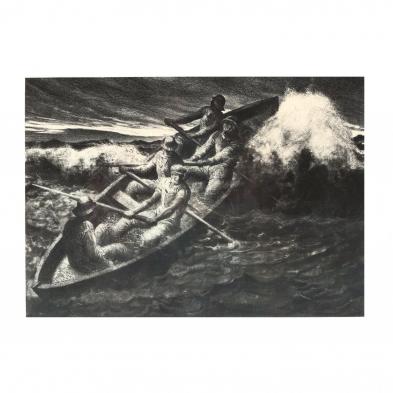

We like to think of art as a cosmic calling, the talent and the will to make it handed down to the select few by divine power. But as any child who wants to be an astronaut and a fireman and a rock star can tell you, or any 40-year old who still doesn't know what he wants to be when he grows up, or any actor or poet or painter who waits tables to pay the bills, career paths are rarely straight. Great artists are no exception - all of the canonical artists whose work is being offered in our Labor Day Auction have their own incongruous back story. Read below to find out who poured concrete to make ends meet and who apprenticed with the local Native American tribe. Here's to being multi-faceted.
Pierre Auguste Renoir
Renoir's talent for the visual arts apparently wasn't his most obvious skill - it was overshadowed by his talent for singing. Singing was the first art form he pursued with formal training, but he had to drop out of school in order to take an apprenticeship at a porcelain factory to help support his family. Renoir didn't begin to study painting until the owner of the porcelain factory noticed Renoir's talent and encouraged his parents to enroll him in art school.
James Abbott MacNeill Whistler
James Abbott MacNeill Whistler had an artistic temperament, to say the least. He was a difficult child, and his parents encouraged him to draw when they found that it gave him an outlet for his moodiness. But despite his early interest in art, his mother had other professional goals for him. As a teenager she enrolled him at Christ Church Hall School, hoping he would become a minister. He wouldn't. When it became clear that religion wasn't his calling, Whistler applied to West Point, where his father had attended and taught. Not surprisingly, given that he found seminary unsuitable, Whistler also chafed against the rigidness of military school. He didn't study, was disrespectful to his superiors, and was constantly in trouble - all of which earned Whistler the distinction of being dismissed from West Point by Robert E. Lee, who was at that time the school's Superintendent.
Raoul Dufy
Raoul Dufy was a beloved, prolific artist in the late 19th and early 20th century. Gertrude Stein said of his work "One must meditate about pleasure. Raoul Dufy is pleasure." Dufy worked in paint, watercolor and printmaking, as well as textile design and fashion. His work was an exuberantly colorful expression of modernity. But for all that his art reveals a zest for life, there's not much known about his own life story, particularly his early years. That said, we do know that Dufy had to work at a coffee importing company to put himself through the Écoles des Beaux-Arts. Hopefully his day job subsidized the caffeine he would have needed to stay awake for his studies.
Salvador Dalí
Salvador Dalí came by his surrealism honestly - he didn't have another job before he became an artist, he had another whole life. Dalí was the third Salvador Dalí - the first was his father, and the second was his older brother, who died nine months before Dalí was born. As a child, Dalí's parents took him to his brother's grave and told him that he was his sibling's reincarnation, a belief Dalí apparently held his entire life. He said of his brother that "[we] resembled each other like two drops of water, but we had different reflections....[he] was probably a first version of myself, but conceived too much in the absolute."
Heinie Hartwig
Aside from having one of the most charming names in art history, Heinie Hartwig is known for his beautifully detailed paintings of the American West. He fell in love with this landscape during his childhood in California, as well as during his travels in Alaska while enlisted in the United States Army. Hartwig was posted in Berlin when the Berlin wall went up, and just barely managed to bring his German wife, Eva, home to America with him. After leaving the Army, Hartwig worked pouring concrete and ran marathons in his free time. In 1964, he held the Northern California record for long distance running. Hartwig didn't start painting until 1970, after teaching himself the techniques of the Old Masters in the evenings. Even after he'd quit his day job to paint full time Hartwig remained an avid outdoorsman - he continued to run, hike, cycle, and hang glide throughout his life.
James E. Allen
James E. Allen is best known for his strong prints of the American laborer, of which he produced a significant number between the World Wars, during the Depression, when the country was acutely aware of the value of hard, honest work. Allen grew up in rural Montana, and it was there that he started depicting men at work outside. But he didn't just learn artistic skills during his childhood - he and his brother also became known as the "Horse Whisperers" after they learned to train horses from the local Blackfoot Indians.














